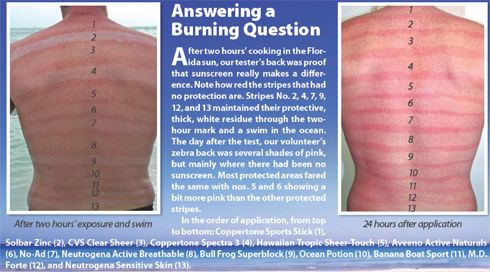
With long days of summer sun coming on fast, I wanted to squeeze in a few skin protection tips. If you havent been following the news lately, dermatology has become a very lucrative line of doctoring. The New York Times had a nice little feature about $25,000 in bills for removing a small white spot of basal cell carcinoma. The report also noted that some hospitals offer higher pay packages to new skin surgeons than to heart surgeons.
My own squamous cell removal in 2009 generated a confetti-storm of paperwork and payments, so Im not surprised that the Mohs surgery I underwent is at the top of Medicares list of potentially misvalued procedures under review for cost adjustment.
Most forms of skin cancer can be prevented, but you have to start early. Although most of my trouble stems from carefree days as a kid in Florida, I like to attribute my clean bill of health for the past few years to some good advice on hats and sun-protective clothing from our readers.
In response to those recommendations, we tested several different wide-brimmed hats, including the popular Tilley Hat. This followed a similar project that focused on duck-bill and baseball-type hats.
Since the last hat test, Ive spent some more time with the contenders and settled on three styles. For great coverage in winds up to 25 knots, Sunday Afternoons Adventure hat has been my favorite. Its angled brim restricts boom-height peripheral vision, but it’s like having my own personal shadetree. For walking around town, the Tilley LTM2 Airflow offers great coverage and presents a more civilized appearance. And for on-the-water activity-dinghy-sailing, paddle-boarding, even surfing-Ive been using the Outdoor Research Helios, which stands up well to dunkings. All three have endured some pretty rough use. The off-white Tilley seems to get dirty fast, but it cleans up pretty easily with simple rinse.

In terms of sun apparel, Ive become attached to my Coolibar travel shirt, a light button down. On the Javelin, or even in the water, the skin-hugging Columbia Anytime shirt, like the slightly heavier Columbia Optimus, is surprisingly cool despite the dark color. My wife likes the Columbia Anytime Hoodie. All of these shirts were featured in our review of sun protective shirts, but as that article pointed out, there is no organization checking the sun-protection claims for apparel. We did our own testing with a UV meter and found that some parts of the same shirt (the Anytime was a good example) can offer more protection than others.
Sunscreen remains a big part of my gameplan, and this year, Ive been looking at so-called natural sunscreens that use no nanoparticles. The one I have been trying most recently is an SPF 33 Sport Sunscreen from Elemental Herbs, a company based in Moro Bay, Calif., that touts an eco-conscious approach to sunscreen. (The very Mill Valley-ish label advertises its GMO-free, gluten-free, vegan, nanoparticle-free, biodegradable, and ocean-friendly formula.) Like the kid-friendly sunscreens from major brands, the Elemental Herbs sunscreen is mineral-based product (22.5-percent zinc oxide), but unlike some of these other products, it claims not to have any nano-particles.
Should we be concerned about zinc nano-particles? Elemental Herbs is one of 208 sunscreens that rated well in the Environmental Working Groups 2013 Guide to Sunscreens, but as the EWG points out, the definition of nanoparticles varies, and it has not found evidence of nanoparticles in sunscreen penetrating the skin. The group does point to other nanoparticle risks.
While Im sure that some of these all natural products are exploiting a vaguely defined marketing niche, I do worry about some of the chemicals found in skin-care products. One of the reasons we’re seeing more natural sunscreens is that groups like the EWG are taking a fairly strong stand against certain kinds of sunscreen and their ingredients. EWG recently released a list of sunscreen ingredients and formulas not to bring on vacation, which includes spray sunscreens and sunscreens with oxybenzone and retinyl palmitate.
The Skin Cancer Foundation has fired back with its own attack on the Environmental Working Groups methodology, saying there is no evidence that these chemicals are harmful. I havent looked enough at these studies, but I like the idea of physical barriers, versus chemical (thus the hats and shirts).
I did notice that the Elemental Herbs product does not have the endorsement of the American Academy of Dermatology or the Skin Cancer Foundation, something we suggested consumers look for in the wake of our own testing and research. According to Elemental Herbs, the certification through these groups is an easy matter, and they aspire to a higher standard. All sunscreens must be cleared by the Food and Drug Administration, which established new consumer protection measures in 2011.
Our report found that some of the most effective sunscreens were the least expensive generics, suggesting that the added value of buying a more expensive sunscreen was simply branding and marketing. As for the Elemental Herbs SPF 33 Sport Sunscreen, so far, it seems to work. It doesn’t go on clear over razor stubble, but it has kept the sun away and my super-sensitive face doesn’t break out. It is on par with some other mineral-only sunscreens for babies that Ive tried, but it goes on a little clearer.
Latest update: The Elemental Herbs stuff has gotten stickier than others I’ve used, isn’t very water resistant, and kid #2 says it “smells funny.” Bottom line: It keeps the sun off and seems skin friendly, but I’m still browsing the EWG recommendations. I’d like to hear what other people find works.

































